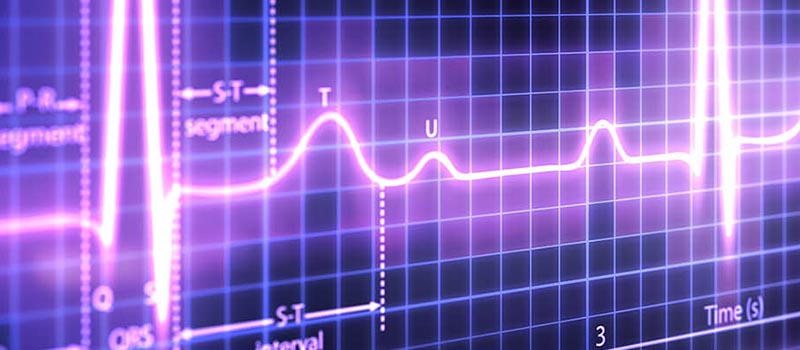Arrhythmia
Cardiac arrhythmia occurs when your heartbeat is too fast, too slow or irregular. When a heart is in arrhythmia, there may not be enough blood flow throughout the body, causing potential damage to the brain, heart and other vital organs. Arrhythmia can be a symptom of structural heart disease.
What happens in cardiac arrhythmia or irregular heart rate?
In a normal heart, electrical signals run from the upper atria to the two lower ventricles in a regular, repetitive rhythm. This causes the heart muscle to contract from top to bottom and pump blood throughout the body. When these signals are irregular, or arrhythmic, the atria and/or the ventricles can quiver instead of beating normally, affecting blood flow.
Types of arrhythmia
Arrhythmias are classified by the speed of the heart rate they cause (fast or slow) and by where they originate (atria or ventricles).
- Tachycardia occurs when the heart beats faster than it should, meaning that the resting heart rate is higher than 100 beats a minute.
- Bradycardia is a slow heartbeat with a resting heart rate of fewer than 60 beats a minute.
Tachycardias in the atria
Atrial fibrillation or A-fib is very common, This rapid heart rate is caused by chaotic electrical impulses in the atria. These signals result in rapid, uncoordinated, weak contractions of the atria that in turn produce an irregular, rapid rhythm of the ventricles. Left untreated, a-fib can lead to serious complications such as stroke.
Atrial flutter is similar to atrial fibrillation and can also lead to stroke.
Supraventricular tachycardia refers to many forms of arrhythmia that originate above the ventricles (supraventricular). An example is Wolff-Parkinson-White syndrome, which occurs when you are born with an extra electrical pathway.
Tachycardias in the ventricles
Ventricular tachycardia is a rapid, regular heart rate that doesn't allow the ventricles to fill and contract efficiently to pump enough blood to the body. Ventricular tachycardia can often be a medical emergency. Without prompt medical treatment, ventricular tachycardia may worsen into ventricular fibrillation.
Ventricular fibrillation happens when rapid, chaotic electrical impulses cause the ventricles to quiver ineffectively instead of pumping necessary blood to the body. This serious problem is fatal if the heart isn't restored to a normal rhythm within minutes. Most people who experience ventricular fibrillation have an underlying heart disease or have experienced serious trauma, such as being struck by lightning.
Long QT syndrome is a heart disorder that carries an increased risk of fast, chaotic heartbeats. The rapid heartbeats, caused by changes in the electrical system of your heart, may lead to fainting, and can be life-threatening. In some cases, your heart’s rhythm may be so erratic that it can cause sudden death. You can be born with a genetic mutation or heart defect that puts you at risk of long QT syndrome. Several medications may cause long QT syndrome.
Bradycardia — A slow heartbeat
Although a heart rate below 60 beats a minute while at rest is considered bradycardia, a low resting heart rate doesn’t always signal a problem. If you’re physically fit, you may have an efficient heart capable of pumping an adequate supply of blood with fewer than 60 beats a minute at rest.
If you have a slow heart rate and your heart isn’t pumping enough blood, you may have one of several bradycardias, including:
- Sick sinus syndrome. If your sinus node, which is responsible for setting the pace of your heart, isn’t sending impulses properly, your heart rate may be too slow (bradycardia), or it may speed up (tachycardia) and slow down intermittently. Sick sinus syndrome can also be caused by scarring near the sinus node that slows, blocks or otherwise disrupts electrical pulses.
- Conduction block. A block of your heart’s electrical pathways can occur in or near the AV node, which lies on the pathway between your atria and your ventricles. A block can also occur along other pathways to each ventricle.
Diagnosing Arrhythmia
Arrhythmias diagnosis has three parts: Information about a patient’s medical and family history, a physical examination and various tests and procedures. A cardiologist or electrophysiologist, a specialist in arrhythmias, usually will coordinate the diagnosis.
- Medical and family history: The doctor will ask for a description of your symptoms and whether you or any direct, biological relatives have had heart disease, high blood pressure or diabetes. The doctor may also ask about current prescriptions and over-the-counter medications, alcohol, drugs or smoking. Stress factors in life also will be explored.
- Physical examination: The doctor will measure the rate and rhythm of your heartbeat, check your pulse and listen for a heart murmur. The legs and feet will be examined for swelling, which could point to an enlarged heart or heart failure.
- Tests and procedures: These range from a simple blood test or chest x-ray to an EKG (electrocardiogram), an echo (echocardiogram) or a treadmill-administered stress test. You may also need to wear a Holter monitor or event monitor. The Holter measures 24 or 48 straight hours of heart activity while the event device is worn for several weeks and only records data when activated by the patient or when it senses irregular heart activity.
Treating Heart Arrhythmia
Many heart rhythm problems do not require any treatment at all. But some do and treatments can vary depending on the severity of your condition. Options may include:
- Medication
- Catheter ablation
- Implantation of a pacemaker
- Implantation of a cardioversion defibrillator

